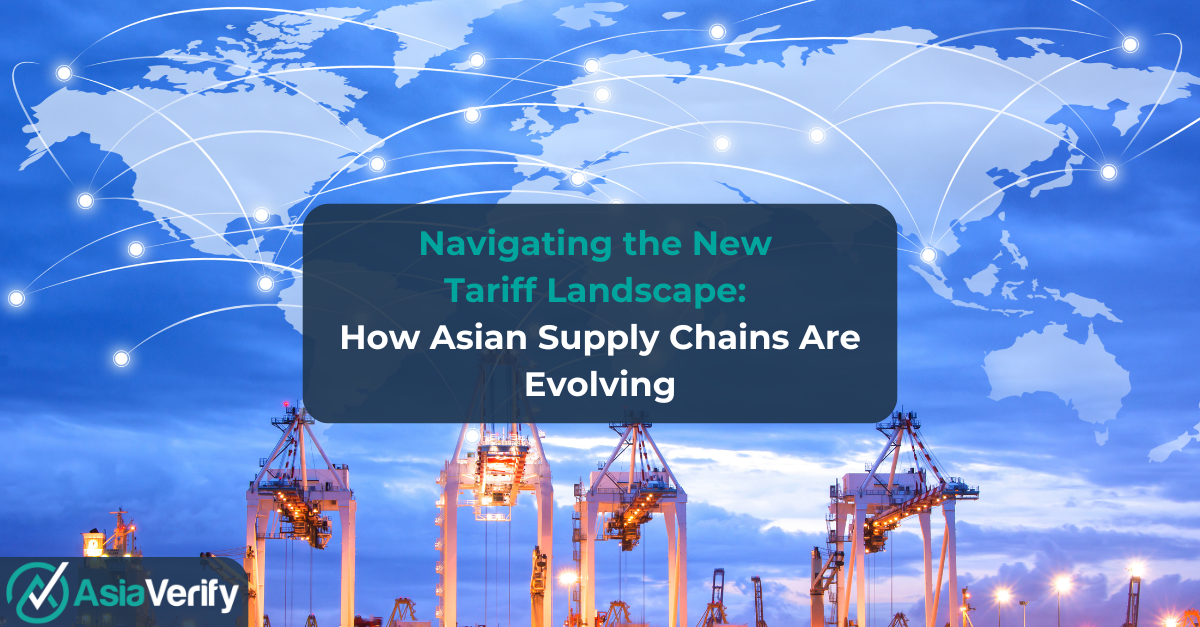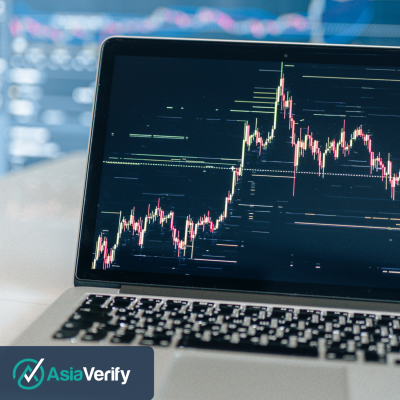By Leas Bachatene ,CEO at AsiaVerify.
This is not a political stance, but a reality check. While the global trade landscape has undergone a shift in recent years, reciprocal tariffs now reshape how businesses approach their Asian supply chains with strategic adaptation, rather than tactical responses. Tariffs imposed on a global basis will have an impact on the supply chains, which means risk exposure. As companies grapple with this rapidly evolving environment, understanding the multifaceted impacts of these tariffs just became essential for maintaining competitive advantage and regulatory compliance.
The great redistribution: Beyond China-Centric manufacturing
The era of concentrated China manufacturing is giving way to a more distributed model. What we’re witnessing isn’t simply companies fleeing China but rather implementing sophisticated “China+N” strategies that balance risk exposure with operational efficiency.
Vietnam has emerged as a primary beneficiary, with its manufacturing sector growing at double-digit rates as it absorbs production capacity in electronics, textiles, and furniture. Thailand’s well-established automotive and components industry has seen significant inflows, while Malaysia has leveraged its semiconductor expertise to attract high-tech manufacturing operations.
This redistribution isn’t merely geographic shuffling—it represents a fundamental reconfiguration of how supply chains function. Companies are creating regional ecosystems where components move across multiple countries during production, each step strategically positioned to optimise tariff exposure while maintaining quality and efficiency.
For instance, a leading electronics manufacturer recently restructured its production flow so that key components are produced in China, undergo substantial transformation in Vietnam, and final assembly occurs in Thailand. This carefully orchestrated process ensures that the finished product qualifies for preferential origin status in its target markets while preserving access to China’s unmatched component ecosystem.
The authentication challenge: When origins matter more than ever
As supply chains redistribute across Asia, customs authorities have intensified scrutiny of product origins. This heightened vigilance stems from legitimate concerns about transshipment schemes designed to evade tariffs.
The authentication challenge is multifaceted. Companies must now verify not just the immediate supplier but understand complete ownership structures, manufacturing capabilities, and compliance histories. Documentation that was once routine now undergoes microscopic examination, and inconsistencies that might have been overlooked previously can trigger comprehensive investigations.
A medium-sized automotive parts importer discovered this reality when their shipments were detained at the U.S. border. Despite having what appeared to be complete documentation from their Vietnamese supplier, customs authorities questioned whether substantial transformation had actually occurred in Vietnam or if the parts were merely being transshipped from China. The resulting investigation delayed shipments by weeks and required extensive additional documentation to resolve.
This case reflects the broader shift toward deeper due diligence and a more data-driven compliance environment. To keep up, businesses must adopt tools and models that offer real-time insights into ownership and trade legitimacy. A great example of this evolving approach can be found in AsiaVerify’s breakdown of the New Credit Data Landscape with the MCRA Model a framework that brings more transparency and precision to compliance, especially in high-risk, high-volume trade scenarios.
Transshipment: The growing compliance risk
The financial incentives for disguising product origins have created a flourishing industry of transshipment schemes. These range from sophisticated operations with falsified manufacturing documentation to simple repackaging facilities that change nothing but the shipping labels.
The implications for legitimate businesses are severe. Companies found to have imported products through transshipment schemes—even unwittingly—face substantial penalties, including retroactive tariffs, fines, and potentially even criminal liability for customs fraud. Beyond the immediate financial impact, the reputational damage can be devastating, particularly for businesses that have built their brand on ethical supply chain practices.
The risk isn’t theoretical. In recent enforcement actions, several major importers faced multimillion-dollar penalties for failing to conduct adequate due diligence on their Asian supply chains, while their executives faced uncomfortable questions from board members and shareholders about compliance oversight failures.
Technology as compliance infrastructure
The complexity of modern supply chains and the heightened scrutiny they face have accelerated the adoption of technological solutions. Blockchain implementation in supply chain documentation creates immutable records of product journeys. IoT devices provide real-time tracking and verification that products actually moved through claimed manufacturing facilities. AI systems analyse documentation patterns to flag anomalies that might indicate compliance issues.
These technologies aren’t merely helping companies avoid problems—they’re creating competitive advantages. Businesses with robust technology infrastructure can respond to customs inquiries in hours rather than weeks, reduce their risk premiums, and provide the transparency that increasingly compliance-conscious customers demand.
A leading apparel manufacturer recently implemented a blockchain-based certification system for its Asian textile suppliers. When U.S. customs questioned the origin of certain fabric components, the company was able to provide immediate access to an immutable record tracking the materials from raw fibre through spinning, weaving, and finishing across three different Asian countries. What might have been a weeks-long investigation concluded in days.
The margin equation: Who bears the tariff burden
The economic reality of tariffs ultimately comes down to who absorbs the additional costs. Initially, many Asian manufacturers attempted to maintain market share by absorbing portions of the tariff burden through reduced margins and operational efficiencies. However, this approach has natural limits, particularly as tariff rates have increased and expanded to cover more product categories and geographies.
The resulting margin compression has forced difficult conversations throughout supply chains. Manufacturers are investing in automation to reduce labour costs, renegotiating with their own suppliers, and in some cases, accepting the reality of smaller profits in exchange for market stability. Companies further down the value chain are similarly evaluating how much of the increased costs they can pass to consumers versus absorb internally.
This recalibration extends beyond simple pricing adjustments. Companies are reevaluating which products remain viable under the new tariff regime, in some cases discontinuing low-margin offerings where the additional tariff costs make them commercially unviable.
From transactions to partnerships: The new supplier ecosystem
Perhaps the most profound change in Asian supply chains is the evolution of supplier relationships. The transactional model—where relationships were primarily defined by price and delivery terms—is giving way to strategic partnerships characterised by deeper integration and shared investment.
These new relationships include knowledge transfer to help suppliers implement compliant manufacturing processes, co-investment in technologies that enhance traceability, and collaborative approaches to regulatory compliance. Forward-thinking companies are establishing regular compliance training programmes with their Asian suppliers, creating shared documentation systems, and developing joint contingency plans for regulatory changes.
A medical device manufacturer exemplifies this approach. Rather than simply imposing compliance requirements on their Thai and Malaysian suppliers, they established a regional compliance center that provides ongoing training, conducts regular audits, and helps suppliers implement documentation systems that meet the increasingly stringent requirements of U.S. customs authorities.
The challenge of compliance is further complicated by regulatory fragmentation across Asia. Rules of origin, documentation requirements, and enforcement priorities vary significantly between countries and change frequently as governments adjust to shifting trade policies.
Companies must now maintain expertise across multiple regulatory regimes or partner with specialists who can navigate this complexity. The cost of this expertise is substantial, but the cost of non-compliance is invariably higher.
The fragmentation extends beyond government regulations to include industry standards and certification requirements. Companies must ensure their redistributed supply chains maintain consistent quality and compliance across all applicable standards, a challenge that requires sophisticated management systems and regular oversight.
Strategic process segmentation
Manufacturing processes that once occurred in a single facility are now being strategically segmented across countries to optimise for both operational efficiency and tariff treatment. Companies analyse their production processes to identify where critical transformations occur that might qualify for “substantial transformation” under various rules of origin, then structure their manufacturing footprint accordingly.
This optimisation is highly technical, often requiring detailed knowledge of both manufacturing processes and customs regulations. A transformation that qualifies as “substantial” under one country’s rules might not meet the threshold in another, creating a complex matrix of considerations for global companies.
Successful companies are creating flexible manufacturing networks that can adapt as regulations change, allowing them to reconfigure production flows without disrupting their ability to serve key markets.
The transparency mandate
Perhaps the most pervasive change is the evolution of supply chain transparency from a competitive advantage to a fundamental requirement. Customers, regulators, and investors increasingly demand verifiable information about where products originate, how they’re produced, and whether they comply with applicable regulations.
Companies that can provide this transparency—backed by credible documentation and verification—gain advantages in customer trust, regulatory clearance speed, and risk profile. Those that cannot find themselves facing increasing challenges on all these fronts.
This transparency mandate extends beyond regulatory compliance to include ethical considerations like labor practices and environmental impact, creating a comprehensive expectation of visibility into all aspects of the supply chain.
This growing mandate for transparency goes far beyond simple regulatory compliance. It now encompasses ethical considerations, such as labor practices, sustainability, and environmental impact. Companies are expected to demonstrate a holistic view of their supply chains, ensuring every step of the process meets ethical and regulatory standards. This shift has made it crucial for businesses to leverage open-source data and verification tools to create an immutable record of their operations. By integrating open source data and advanced tracking technologies, companies can provide reliable insights into each stage of production and ensure compliance with both local and international standards.
The final adaptation is the incorporation of geopolitical risk premiums into business models. Companies recognise that U.S.-Asia trade tensions represent a long-term structural reality rather than a temporary disruption, and they’re adjusting their financial models accordingly.
These adjustments include maintaining higher inventory levels to buffer against disruptions, building redundancy into critical supply pathways, and incorporating scenario planning for further tariff escalations into strategic decision-making. The result is a more resilient but also more costly supply chain model that acknowledges geopolitical risk as a core business consideration rather than an external anomaly.
How AsiaVerify can help
Navigating this complex landscape requires specialised knowledge and capabilities that many companies lack internally. AsiaVerify offers comprehensive solutions designed specifically for the challenges of Asian supply chain compliance:
- Supplier Verification: Our intelligence platform provides data and insights into more than 440 million entities for complete visibility across 13 Asian jurisdictions through a unique open search capability.
- Technology Implementation Support: Our technical specialists help companies implement and integrate verification technologies to create defensible compliance records through access to 13 government registries and official databases.
- Regulatory Monitoring: Our local presence across Asia enables real-time tracking of regulatory changes that might impact supply chain compliance, allowing proactive adaptation rather than reactive scrambling.
- Risk Assessment: Our platform provides comprehensive evaluations of supply chain vulnerabilities, helping companies identify and address compliance risks before they trigger enforcement actions.
The tariff-driven transformation of Asian supply chains represents both challenge and opportunity. Companies that adapt strategically—redistributing their manufacturing footprint, implementing robust compliance systems, and building transparent, resilient supply networks—will not merely survive this new landscape but thrive within it.
At AsiaVerify, we partner with forward-thinking businesses to navigate these complexities, turning potential disruption into sustainable competitive advantage.
By Leas Bachatene ,CEO at AsiaVerify






